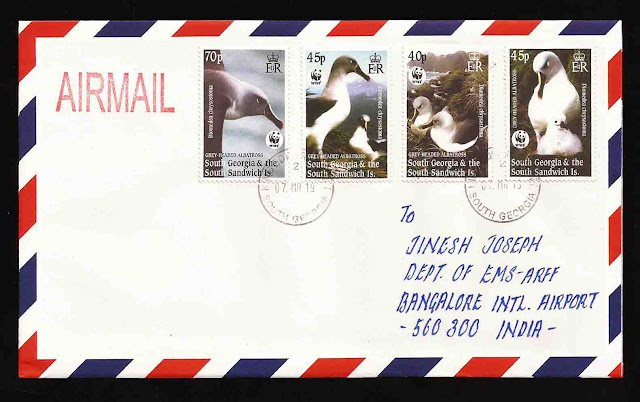South Georgia and the
South Sandwich Islands (SGSSI) is a British Overseas Territory
in the southern Atlantic Ocean. It is a
remote and inhospitable collection of islands, consisting of South Georgia and a chain
of smaller islands known as the South Sandwich Islands. South Georgia is 165
kilometres (103 mi) long and 35 kilometres (22 mi) wide and is by far
the largest island in the territory. The South Sandwich Islands lie about 700
kilometres (430 mi) southeast of South Georgia. The territory's total land
area is 3,903 km2 (1,507 sq mi). The Falkland Islands are about 1,300 kilometres (810 mi)
west-northwest from its nearest point.
No permanent native
population lives in the South Sandwich Islands, and a very small non-permanent
population resides on South Georgia. There are no scheduled passenger flights
or ferries to or from the territory, although visits by cruise liners to South
Georgia are increasingly popular, with several thousand visitors each summer. The
United Kingdom claimed sovereignty over South Georgia in 1775 and
the South Sandwich Islands in 1908. The territory of "South Georgia and the
South Sandwich Islands" was formed in 1985; previously, it had been
governed as part of the Falkland Islands Dependencies.
Argentina claimed South Georgia in 1927 and claimed the South
Sandwich Islands in 1938.
Argentina maintained a
naval station, Corbeta Uruguay, on Thule Island in the South Sandwich Islands from 1976 until
1982 when it was closed by the Royal Navy. The Argentine claim over South Georgia contributed
to the 1982 Falklands War, during which Argentine
forces briefly occupied the island. Argentina continues to claim sovereignty over South Georgia and the
South Sandwich Islands. Toothfish are vital to the islands'
economy; as a result, Toothfish Day is celebrated on 4 September as a bank holiday in the territory.
South Georgia supports many sea birds,
including albatross, a large colony of king penguins, Macaroni penguins and penguins of various other species, along with petrels, prions, shags, skuas, gulls
and terns. Birds unique to the archipelago are the South Georgia shag, South Georgia pipit, and
the South Georgia pintail.
Both South Georgia and the South Sandwich Islands have been identified as Important Bird Areas (IBA)
by BirdLife International. Seals frequent the islands, and whales
may be seen in the surrounding waters. There are no native land mammals, though
reindeer, brown rats and mice were introduced to South Georgia through human
activities. Reindeer were introduced to South
Georgia in 1911 by Norwegian whalers for meat and for sport hunting.
In February 2011, the authorities announced that due to the reindeer's
detrimental effect on native species and the threat of their spreading to
presently pristine areas, a complete cull would take place, leading to the
eradication of reindeer from the island. The eradication began in 2013 with
3,500 reindeer killed. Nearly all the rest were killed in early 2014, with the
last (about 50) cleared in the 2014/15 southern summer.
The seas around South Georgia have a high
level of biodiversity. In a recent study
(2009–2011), South Georgia has been discovered to contain one of the highest
levels of biodiversity among all the ecosystems on Earth. In respect to species, marine inhabitants
endemic to this ecosystem outnumber and (in respect to biodiversity) surpass
well-known regions such as the Galápagos or Ecuador. The marine ecosystem is thought
to be vulnerable because its low temperatures mean that it can repair itself
only very slowly. On 23 February 2012, to protect marine biodiversity, the
territory's government created the South Georgia and the South Sandwich Islands
Marine Protected Area – comprising 1.07 million km2
(410,000 sq mi).
The first stamps specifically for South
Georgia were issued in 1944 and consisted of overprints on stamps of the Falkland Islands for use in South Georgia when it was part of
the Falkland Islands Dependencies.
From 1946 to 1963, South Georgia used stamps of the Falkland Islands
Dependencies. In 1963, British Antarctic Territory
was formed, leaving only the island groups of South Georgia and the South
Sandwich Islands in the Falkland Islands Dependencies. From 1963 to 1979, South
Georgia had its own stamps simply marked South Georgia. From 1980 to 1985,
South Georgia again used stamps of the Falkland Islands Dependencies. From 1986
stamps of the territory are inscribed South Georgia & South Sandwich Is.
Thesearranged by Glenys from Falkland Island. Philately is one of the main income source of these islands. The stamps of SG&SSI are beautiful in design and thematic too. The covers posted on February 26, 2016 and received in my hands on April 04, 2016.







No comments:
Post a Comment
Note: only a member of this blog may post a comment.